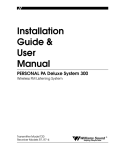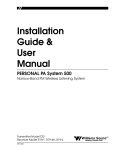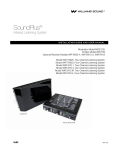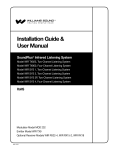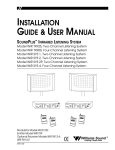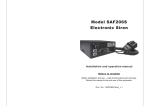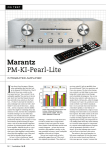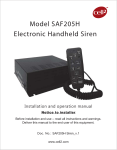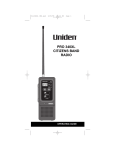Download Williams Sound R700 User manual
Transcript
FM Transmitter System Installation and User Manual Transmitter Model PPA T21 PPA Receiver Models, R7, R7-4, R7-6, R16, R700 MAN 056 PERSONAL PA BROADCASTING SYSTEM Installation and User Manual Contents: Page: Transmitter Controls and Features 3 Transmitter Set-Up and Operation 4 Antenna Connection Power Connection Audio Connection Using a Microphone Connecting to a Sound System Input Selector Switch High Pass Filter Switch RF Power Switch 4 4 4 4 5 6 6 6 Receiver Instructions 7 Battery Information 8 Receiver Management 8 Using a Remote Antenna 9 Troubleshooting 9 Radio Interference Problems 10 Warranty 11 License Instructions 12 Audio Processor Options 13 Specifications 14 Transmitter Model T21 Controls and Features: Note: Taking a few minutes now to read these instructions will save time and ensure proper system operation. The T21 is an FM Transmitter that operates in the 72 to 76MHz business frequency band. It can be used with a microphone as a stand-alone system, or it can be connected to an existing sound system. A Part 90 FCC license is required. FM Auditory AssistanceTransmitter Power Audio Level Ok 1 2 Hi Transmit Status + Adjust 3 Williams Sound On 4 5 WB Tape Out/Phones NB 6 7 8 T21 Front Panel: 1. Power LED - Indicates power ON. 2. “OK” Audio LED - Flashes to indicate nominal audio input level. 3. “HI” Audio LED - Flashes to indicate excessive audio input level. 4. Audio Adjust Control - Adjusts audio input level. 5. Transmit “On” LED - Indicates a valid channel has been selected and the RF carrier is on. 6. Transmit “WB” LED - Indicates a valid wide-band channel has been selected. 7. Transmit “NB” LED - Indicates a valid narrow-band channel has been selected. 8. Tape Output - 1/4” TRS jack provides line-level, unbalanced audio output for tape recorders, relay feeds, or a stereo or mono headphone for monitoring. T21 Rear Panel: Balanced Audio Input IN 2 IN 3 COM IN 1 Auditory AssistanceTransmitter 1. Audio Input Jack - Concentric XLR/ phone plug jack forFM balanced and unbalanced Mic/Line/70V audio inputs. Provides simplex power for condenser mics. Unbalanced Audio Inputs Antenna 2. Audio Inputs - Screw terminals accept 3 unbalanced, line-level inputs. All inputs are actively Channel mixed. Hi-Pass Filter RF Power Select 0 1 Mic 70V 20 Hz 725 Hz -12dB Max Power: 24 VAC, 60 Hz, 10VA 3. Input Level Selector - 3-way switch jack only. 175 Hzselects Mic/Line/70V input level -6dBfor concentric Line Use with TFP 016 Power Supply 1st 2nd 75 Ohm Made in USA Digit Digit Williams Sound Corp. 4. High-Pass Filter - 3-way switch provides low-frequency roll-off to reduce system noise and equalize frequency 1 response 2 for hard 3 of hearing 4 listeners. 5 6 7 8 5. Channel Selector Switches - Two rotary switches determine the operating frequency. Selects 8 wide-band channels and 68 narrow-band channels. 6. Antenna Output - Connector for remote antenna. The standard T21 includes a “rubber duckie” type antenna that threads into the top of the cabinet. For installations requiring rack mounting or remote antenna locations, the T21 has an optional coaxial antenna (ANT 005). 7. RF Power Switch - 3-way switch determines RF output power. It is used to reduce RF hum and buzz in amplifiers/mixers/etc. that are disturbed by RF produced by the transmitter. 8. Power Supply Connection - Coaxial DC connector for 24VAC remote power supply. Transmitter Set-Up and Operation: Page 3 Step 1. Install the Antenna The "rubber duckie" whip antenna fits into the hole on top of the transmitter and threads onto a mounting stud inside. Guide the antenna onto the stud and turn it clockwise to tighten. Do not use excessive force to tighten the antenna. It only needs to be finger-tight. See page 9 for instructions on using the Transmitter with a remote antenna. Step 2. Connect the Transmitter to Power The T21 is supplied with a wall transformer power supply (TFP 016). Connect the power cord plug to the "Power" connector on the rear panel of the T21. Then plug the transformer into a 120 Volt, 60 Hz wall outlet. The indicator light on the front panel of the T21 should glow when the power is connected. There is no on/off switch. Due to low energy consumption, the T21 is designed to run continuously. The wall transformer can be plugged into a switched outlet that turns on when the other sound equipment is turned on. If turning the T21 on creates a hum or buzz in the sound system, see the Troubleshooting section on page 9. Step 3. Audio Connections If you will be using the T21 with a microphone as a stand-alone system: Any professional low-impedance microphone may be used with the T21. Plug the microphone into the concentric jack (“Balanced Audio Input”) on the rear panel of the T21. The T21 supplies positive DC voltage to power condenser microphones per DIN45596. Make sure the input selector switch is in the MIC position. Talking into the microphone should cause the audio indicator light to flash on the front panel. If you use both the Microphone input and the Audio Input on the T21, the signals will be mixed together. If you will be using the T21 with an existing sound system: Refer to the Overall System Diagram, above. The T21 has been designed to accept virtually any type of audio input, with up to four different input signals actively mixed together. Following are the best sources for an audio signal from the sound system: Desirable Signal Sources: 1st Choice: 2nd Choice: 3rd Choice: Page 4 TAPE OUT or LINE OUT Jack BOOSTER or BRIDGING Jack Speaker Terminal, or Speaker transformer tap Microphone Wiring Detail Following are the input connection options for the T21 Transmitter: Microphones Sound System Amplifier Loudspeakers Balanced Audio Input COM IN 1 IN 2 IN 3 FM Auditory AssistanceTransmitter Unbalanced Audio Inputs Antenna Channel Line-Level Output Select Hi-Pass Filter 70V 20 Hz Mic Line 0 RF Power 1 725 Hz 175 Hz Made in USA Max -12dB 1st Digit FM Pocket Receivers with Earphones 2nd Digit 75 Ohm -6dB Power: 24 VAC, 60 Hz, 10VA Use with TFP 016 Power Supply Williams Sound Corp. T21 Transmitter Overall System Diagram “Balanced Audio Input” Concentric Jack: Accepts balanced XLR or TRS 1/4” Mic-Level or Line-Level Inputs Accepts unbalanced Mic-Level or Line-Level Inputs Accepts unbalanced Speaker-Level Inputs (25V, 70V speaker line) See the diagram on the next page for connection details. “Unbalanced Audio Input” Screw Terminals: Accepts one to three unbalanced line-level signals, which are actively mixed. The three inputs share a common ground connection. Use the audio cable and adapter supplied to connect the T21 "Audio In" jack to an appropriate audio output jack on the sound system mixer or amplifier. If your amplifier or mixer does not have RCA-type connectors, you can obtain adapters from your Williams Sound Authorized Dealer or a local radio parts store. If the TAPE OUT jack is already in use, a Y-Cord can be used to connect the T21 and a second device to the same jack. Step 4. Set the Input Selector Switch If you are using the combination XLR/phone plug input jack, make sure the selector switch is set in the proper position as shown above. Step 5. Set the Hi-Pass Filter Switch The High-Pass Filter switch is used to reduce low frequencies. It is normally used in the middle (175Hz) position to provide high frequency emphasis that improves speech understanding. If the program content is primarily musical, it can be used in the left (20Hz) position. The right position (725Hz) may From Sound System Line Output RCA to RCA Cable To T21 Concentric Jack RCA to 1/4" Adapter Using the Audio Cable Supplied with the System Page 5 Audio Connection Wiring Detail be used for further low frequency reduction, or it may be used to reduce low frequency system noise due to pick up of ventilation system noise, etc. Step 6. Set the RF Power Switch In some situations, the radio signal produced by the transmitter can enter other types of equipment and create a hum or buzzing sound in the sound system. This is due to poor RF protection in the other equipment, NOT a problem with the transmitter. The normal switch position is MAX power (right). If you encounter a hum or buzz in the sound system when the T21 Transmitter is turned on, move the switch to the -6dB (middle position). If the buzz persists, move the switch to the -12dB (left) position. If this does not solve the problem, refer to the Troubleshooting Section. Reducing the power will reduce the system range, but usually still covers the entire seating area. Step 7. Set channel switches to desired channel. The transmitter must be set to the same channel as the receivers. See the channel chart on top of the transmitter. Step 8. Use a receiver to test the system and set the input level control. Receiver Operating Instructions: Receiver Models R7, R7-4, R7-6, R16, R19, R19-4: Page 6 Step 1. Battery Installation: Open the battery compartment by using a coin in the coin slot in the bottom of the receiver. Press the battery into place, observing proper battery polarity. Step 2. Plug the earphone or headphone into the earphone jack. Step 3. Turn the receiver on by rotating the volume control in the direction of the arrow on top of the case. Turning the knob in the direction of the arrow will increase the volume. Turning the knob against the arrow will decrease the volume. To avoid draining the battery, make sure the receiver is turned off when not in use. Step 4. If you are using the T21 with an existing sound system, make sure the sound system is turned on. Have someone speak into a microphone while you listen with the receiver and earphone. You should be able to hear their voice through the receiver. If you are using the T21 with a microphone, have someone speak into the microphone while you listen with the receiver and earphone. You should be able to hear their voice through the receiver. Step 5. The T21 Transmitter has a screwdriver-adjust input level control located on the front panel to compensate for different input signal levels. Adjust the control so the “OK” audio light flashes with the signal. It is alright if the “HI” light comes on occasionally. Reduce the signal level by turning the control counter-clockwise if the “HI” light is on all the time. If the “OK” light does not come on at all, turn the T21 input level control clockwise to increase the signal. If the input level control is fully clockwise and the “OK” light still does not come on, you will need to increase the signal level at its source (mixer or P.A. amplifier). The phone jack monitors the sound exactly as it is transmitted. Additional Instructions for Receiver Model PPA R7-4, PPA R7-6: The R7-4 and R7-6 receivers feature a channel selector knob on top of the receiver. Turn the selector knob until you hear the desired program. Additional Instructions for Receiver Model R16: The R16 Receiver features a microphone input and dual volume controls. The taller knob turns the receiver on and off and controls the FM signal level. The shorter knob controls the microphone signal level. By adjusting the two volume controls, you can hear a mixture of the FM signal and nearby sounds picked up by the microphone. For more information, see the instructions included with the R16. Instructions for Monitor Receiver Model R700: Step 1. Plug the R700 power cord into a 120 VAC, 60 Hz electrical outlet. Step 2. Attach the antenna to the connector on the rear panel of the R700. Step 3. Turn power switch on and adjust volume control until you hear the signal from transmitter. Using An External Antenna with the R700: The optional ANT 005 Coaxial Antenna may be used with the R700 to extend the reception range. Using An External Speaker with the R700: An external loudspeaker may be used with the R700. Connect the + (plus) loudspeaker wire to the tip connection of a 1/4" mono phone plug. Connect the - (minus) loudspeaker wire to the sleeve connection of the 1/4" mono phone plug. Insert the plug into the external speaker jack on Page 7 the rear panel of the R700. This will cut out the built-in speaker and deliver up to 1 Watt of audio power into an 8 Ohm speaker. The R700 speaker output jack may also be connected to the high level input of a PA amplifier. See the instructions included with the R700 for more details. Battery Information for Receivers: In normal use, a heavy-duty 9 Volt battery such as the Eveready 216 will last about 10 hours. Alkaline batteries such as the Eveready 522 will provide about 17 hours of use. If the sound becomes weak or distorted, replace the battery. The indicator light may still be on, even with a battery that is weak. Do not leave dead batteries in the receivers. Rechargeable Batteries: The receivers can also use a rechargeable battery. We recommend only the 7-cell, 8.4 Volt types (BAT 003). A fully-charged battery (Williams BAT 003) will provide about 5 hours of use per charge. The battery may be recharged without removing it from the receiver. The BAT 005 Single Charger has a cord that plugs into the receiver "EAR" jack to charge the battery. The CHG 1269A Multiple Charger can charge 12 receivers simultaneously through the receiver "EAR" jacks. The receiver should always be turned OFF while charging. It takes about 14 hours to fully charge the battery. To ensure long battery life, the battery should be completely drained before recharging. Using the battery for short periods of time (less than 1 hour) followed by charging will result in short battery life. If the BAT 005 Single Charger or CHG 1269A Multiple Charger is used, receivers can be left charging continuously when not in use. See the instructions included with the CHG 1269A for more information. DO NOT ATTEMPT TO RECHARGE DISPOSABLE BATTERIES! AVOID SHORTING THE PLUS AND MINUS BATTERY TERMINALS TOGETHER WITH METAL OBJECTS. BATTERY DAMAGE AND BURNS CAN RESULT! DO NOT MIX RECHARGEABLE BATTERIES AND CHARGERS FROM DIFFERENT MANUFACTURERS. Suggestions for Receiver Management and Earphone Sanitation: Different types of facilities use different approaches for receiver management and earphone sanitation. Following are some alternatives that other customers have used successfully: 1. Regular users purchase their own receiver and take care of their own batteries and earphone. 2. Some facilities label the receiver and earphone with the names of regular users so each person uses their own receiver and earphone. 3. Ushers issue receivers to people who request them. Earphones are sanitized after use. Foam ear cushions can be replaced or washed with a mild detergent, rinsed thoroughly and air-dried. The EAR 022 Surround Earphone can be sanitized with an alcohol pad. 4. The receivers are stored in a multiple compartment storage case with a credit card or driver's license left as collateral for the receiver. 5. Regular users purchase their own earphone or headphone and bring them to use with receivers at the facility Using a Remote Antenna with the T21 Transmitter: The ANT 005 remote Coaxial Antenna is available for applications requiring rack-mounted transmitters, or for use in facilities where a remote antenna is needed for maximum operating distance. DO NOT CUT OR ALTER THE ANTENNA CABLE BEFORE READING THE INSTRUCTIONS BELOW! Page 8 The ANT 005 Coaxial Antenna is a 15 foot coaxial cable with an 80-inch antenna built onto the other end. The last 80 inches of the antenna is the active element, which is covered by nylon braid. The active element should never be altered. The remainder of the antenna cable is RG-59 coax feedline. If you have excess cable, cut the excess off and install appropriate in-line connectors. If you need a longer feedline, the cable can be cut and an extension cable added with appropriate connectors. Remote Antenna Location Guidelines: For maximum signal strength, it is best to select an antenna location somewhere within the listening area. The preferred location is towards the front of the listening area and above the seats. The active element (nylon braid covered portion) must be kept straight, not coiled, in a vertical orientation. Radio signals will generally pass through non-metal structures. The antenna can be mounted on a wall, in a corner, or behind a wooden beam. It may also be hung vertically from the ceiling, with a small weight attached to the end to make it hang freely. If you need to run the feedline through a wall, a 1/2" hole is necessary to pass any connectors through. Avoid placing the antenna on steel beams or near structural steel elements. Metal plaster lath, metal studs, ductwork, and foil-backed insulation can absorb radio energy, greatly reducing the range of the system. DO NOT put the antenna element inside a metal conduit. The feedline may be routed through metal conduit, but NOT with microphone cables or AC power wiring. Nylon clamps and screws are provided to attach the Coax Antenna to a wall. Locate the clamps every 3 - 4 feet. DO NOT bend the cable sharply at any point. Allow at least a 3" radius for turns. DO NOT staple the cable in place. Use the cable clamps provided or hang the antenna from the excess nylon braid at the end of the antenna element. Troubleshooting Guide for the T21 Transmitter: Symptom: Transmitter "Power" light not on. 1. Make sure the wall transformer is plugged into the transmitter. 2. Make sure the electrical outlet is on. Symptom: No sound through receivers. 1. If some of the receivers work, but others don't, check for bad batteries or earphones on the receivers that aren't working. Check to see that the receiver frequency matches the transmitter frequency. Check the frequency selector switches on the transmitter and read the frequency on the chart on top of the Transmitter. The receiver frequency is indicated inside the back cover of the receiver. If they do not match, see the Tuning Instructions. 2. If none of the receivers work, check to see if the power is connected to the transmitter and the "Power" light is on. Check to see if the transmitter and receivers are set on the same frequency. 3. Check to see if the transmitter is connected properly to the sound system. See page 5. 4. Turn the screwdriver-adjust input level control located on the T21 front panel clockwise to increase the input signal strength until the audio indicator light flashes. 5. If you are not using an input signal from a sound system, make sure the microphone is plugged into the "Mic" jack on the rear of the T21 transmitter and the input selector switch is in the MIC (left) position. 6. Make sure the antenna is installed and connected properly. See pages 4 and 9. Symptom: Sound through receivers is loud, but distorted. 1. Turn the screwdriver-adjust input level control located on the T21 front panel counter- Page 9 clockwise to decrease the input signal strength. Make sure the “HI” audio light is not on continuously. Symptom: Sound through the receivers is weak and noisy. 1. Turn the screwdriver-adjust input level control located on the T21 front panel clockwise to increase the input signal strength until the audio indicator light flashes. The audio fed into the T21 may be noisy or weak. Use a headphone in the Phones jack on the front of the T21 to listen to the input signal. If it is weak and noisy from the phones jack, turn up the appropriate mixer control or try a different audio source. 2. Increase the input signal level from the sound system by turning up a mixer control. 3. Make sure a valid wide-band channel is selected and make sure the transmitter and receivers are tuned to the same channel. Symptom: Buzzing or humming noise in sound system. 1. Try moving the “RF Power” switch to the -6dB or -12dB position. This will reduce the system range somewhat. 2. Some amplifiers and mixers are susceptible to RF pick-up from the transmitter. Call your Authorized Dealer or Williams Sound for help. Symptom: Scratchy noise when receiver volume control is adjusted. 1. Open the back of the receiver case by opening the battery compartment. Keep lifting on the battery door and the back of the receiver case will open like a book. 2. Remove the screw from the center of the volume control and remove the knob. 3. Lift the clear plastic cover on the control and spray GC SPRA-KLEEN, LPS Contact Cleaner, or equivalent into the control. Replace the knob and rotate the control several time. 4. Replace the screw and close the case. Radio Interference: The PERSONAL PA is usually not disturbed by other radio services, however there is no such thing as a clear or exclusive channel for ANY radio service. One of the unique features of the Williams Sound PERSONAL PA System is that the operating frequency can easily be changed in the field to avoid interference. There are 10 wide-band and 50 narrow-band frequencies for hearing assistance use. The PERSONAL PA can be quickly changed to any of these frequencies by your Williams Sound Authorized Dealer. The Transmitter is changed first. Then the signal produced by the Transmitter is used to tune the receivers. Transmitter Frequency Change Procedure: (1) Set the two rotary “Channel” selector switches to match the desired channel listed on the chart on top of the transmitter. One of the 8 wide-band channels must be selected for use with the R7, R7-4, R7-6, R700,or R16 Receivers. The narrow-band channels are available for use with a narrowband receiver that will be available in the future. Page 10 Receiver Frequency Change Procedure: The R7 receiver tuning is determined by a single tuning coil, and is stabilized by phase-locked-loop circuitry. A plastic tuning wrench (PLT 005) is needed to adjust the receiver tuning coil. (1) Use the PPA transmitter as a tuning signal source. Make sure there is some kind of audio input (tape or radio) to the transmitter so you have something to listen to. (2) Disconnect the antenna from the transmitter. The receiver must be tuned under weak signal conditions. (3) Open the back of the receiver to expose the circuit board. Open the receiver battery flap first. The receiver back snaps open like a book. Hold the receiver near the transmitter while tuning. (4) Use the diagram below to locate the tuning coil. Use the earphone supplied with the receiver to listen for the transmitter signal while you adjust the tuning coil with the tuning wrench. Adjust the tuning coil slowly and carefully. Do not press down on the tuning slug. Adjust for maximum signal. (5) Re-tune all the receivers and mark the new frequency inside the case for future reference. Warranty The Williams Sound PPA Transmitter is warranted against defects in workmanship and materials for FIVE YEARS. PPA Receivers are warranted against defects in workmanship and materials for THREE YEARS. Microphones, earphones, cables, carry cases, rechargeable batteries and chargers are warranted against defects in workmanship and materials for 90 DAYS. This warranty does not extend to intentional or accidental physical damage. This warranty applies only to products returned to Tuning Coil Receiver Case Open Receiver Tuning Coil Location Williams Sound for service. Please complete and return the Warranty Registration Card included with the system. To return a product for service, call 1-800-843-3544 and request a Return Authorization (RA) number. FCC License Instructions: The T21 Transmitter requires an FCC license for legal operation. We have enclosed a license form for your convenience. Complete the form, following the instructions below, and mail it to the FCC at the address listed. There is a $80.00 filing fee, payable to the FCC. When the application is approved and payment is received, the FCC will mail the license to you. Important Note: Be sure to fill in all items completely, even if you are duplicating information. Do not use phrases like "see above." The FCC will reject incomplete applications. Page 11 Instructions for FCC License Application, Form 574: STEP 1: Determine your Transmitter operating frequency. Your T21 was shipped to you pre-set on Channel E, 72.9MHz. If you have not changed the system frequency, write 72.9MHz on the line below. If you have changed the system frequency, look at the frequency-programming label. Look at the switch settings and read the corresponding frequency. Write that frequency on the line below. TRANSMITTER FREQUENCY:______________________________ STEP 2: (A) Make a photocopy of the license application Form 574. (B) Using a pencil, fill in the photocopied form as follows: BOX 1: Enter the system frequency from STEP 1, above, on the first line of BOX 1. BOX 2: Enter "MO" on the first line of BOX 2. BOX 3: Enter the number of Transmitters you will be using on the top line. BOX 4: Enter "16K0F3E". BOX 5: Enter ".018". BOX 6 - 11: Skip BOX 12: Enter the number of Transmitters you will be using on the "Portable" line inside BOX 12. BOX 13: Enter ".2" on the first line. (Area of operation ... is .2 miles radius of station A.) Fill in the next two lines with the latitude and longitude of your location in degrees and minutes. Fill in 00" for seconds. A local library can supply this information. For example: Degrees Minutes Seconds Direction Latitude 42 27 00 N Longitude 98 15 00 W BOX 14: Enter the street address of your facility on line A. BOX 15: Enter your city on line A. BOX 16: Enter your county on line A. BOX 17: Enter the two-letter abbreviation for your state on line A. BOX 18: Enter the street address, city, state, and telephone number where a person responsible for system operation may be reached. You must fill this in, even if same information as above. BOX 19: Skip BOX 20: Enter "IB". BOX 21: Enter the legal name of the person, business, or organization applying for the license. BOX 22: Enter the mailing address to which the license and any further correspondence should be mailed. Fill it incompletely, even if it is the same as the address above. BOX 23: Enter the city name for the license mailing address. BOX 24: Enter the two-letter state abbreviation. BOX 25: Enter the ZIP Code for the license mailing address. BOX 26: Enter an "X" in the "NO" Box on the first line. BOX 27: Skip. BOX 28: Skip. BOX 29: Skip. BOX 30: Enter an "X" in the box that best describes your organization. BOX 31: Enter "90.75A" in the small box marked "Give Rule Section" inside of BOX 31. Also enter a short, clear statement that includes a general explanation of your business or activity and how the Transmitter will be used. BOX 32: Enter an "X" in the "New Station" box. BOX 33: Enter an "X" in the "Yes" box. BOX 34: Enter an "X" in the "No" box. BOX 35, 36: Skip. BOX 37: Enter the name and phone number of the person completing this form. Fill this in completely, even if you are duplicating information. Page 12 BOX 38: Skip. STEP 3: (A) Using the completed photocopy as a guide, TYPE the information onto the license form. (B) Type in the name and phone number of the authorized applicant and the date where indicated. Be sure to sign the completed form. (C) Type an "X" in the box that best describes the person signing the application form. (D) Mail the signed, completed form and a check for $80.00 made out to the FCC to: Federal Communications Commission P.O. Box 358220 Pittsburgh, PA 15251-5220 (E) Celebrate! You're finally done. Maybe you'd like to try the new tax forms next? T21 Transmitter Specifications: Dimensions, Weight: Color: Rack Mount: Power: FCC ID: Operating Frequencies: Deviation: Pre-Emphasis: RF Field Strength: 8.45" (21.5cm) W x 8.18" (20.8cm) D x 1.72" (4.4cm) H, 3lbs. (1.5kg) Black epoxy paint with white legends One IEC rack space high, one or two units can be mounted in a single rack space with optional RPK 005 (single) or RPK 006 (double) Rack Mount Kits External power supply(TFP 016), 24VAC, 50 or 60Hz, 19VA, 450mA max. current drain CNMT21 72 - 76MHz, 8 wide-band and 68 narrow-band channels, ±.005% stability, 0-50˚C ± 25kHz max. for wide-band channels, ± 5kHz max for narrow-band channels Wide-band: 75µsec, narrow-band: 300µsec 20,000µV/m at 30m max. with ANT 005, 120mW typical T21 Audio Processor Options Compressor Mode: The audio processer in the T21 is capable of three modes of operation. The standard setting provides compression as shown. Compression is used for hearing assistance to limit the dynamic range of the audio signals. Hearing impaired people generally have a reduced tolerance for wide dynamic range. Noise Reduction Mode: The T21 can also be configured for for 2:1 compression. This is for use only with a receiver that has a 2:1 expansion circuit for noise reduction. Noise reduction is typically used in narrow-band operation for high quality audio. Soft-Limit Mode: The T21 can also operate in a soft-limit mode, which allows full dynamic range of audio signals. This mode may be preferred for musical programs, but may provide too much dynamic range for hearing impaired listeners. For assistance in selecting an alternate audio processing mode, contact Williams Sound technical assistance at 1-800-328-6190. Page 13 Nominal Range: AGC Options: Frequency Response: Signal to Noise Ratio: Front Panel: Power Indicator: RF Indicators: Audio Indicators: Audio Level Control: Tape Output: Rear Panel: Audio Inputs: Balanced Audio Input: Mic Input Levels: Line Input Levels: 70 Volt Input Levels: Unbal. Audio Inputs: Input Selector Switch: High-Pass Filter Switch: RF Output Switch: Antenna Outputs: Power Connections: Channel Selector: Wide-band: 300-500ft. (91-152m), Narrow-band: 800-1200 ft. (244-366m) (1)standard variable slope compressor/limiter (2)Noise Reduction (3)Soft Limit (4)Hard Limit Wide-band: 30Hz - 15kHz ±3dB, .25% Max. THD Narrow-band: 30 Hz - 5,000 Hz, .25% Max. THD Wide-band: 60dB with PPA R7 Receiver Green LED Green LED "On" indicates transmitter RF is on Amber LED "WB" indicates wide-band channel selected Amber LED "NB" indicates narrow-band channel selected Amber LED "Ok" for nominal input signal level Red LED "Hi" for excessive input signal level Rotary pot, screwdriver adjust, used with audio indicator lights 1/4” jack, 600mV, 100Ω source impedance, also drives mono or stereo headphone All inputs are actively mixed into a single signal, allowing use of mono, stereo, 3 channel or 4 channel audio sources Combination 3-pin female XLR/1/4” stereo jack, accepts balanced or unbalanced microphone and line level inputs, 25V or 70V audio input Lo-Z, 100µV min. to 50mV max. 1mV nominal, 3kΩ input impedance Supplies simplex power 20V (DIN45596) for condenser mics 21mV min. to 10V max., 212mV nominal, 100KΩ input impedance 216mV min. to 100V max., 2.16V nominal, 100KΩ input impedance Four screw terminals, three unbalanced line-level inputs, one ground, actively mixed 3-position slide-type , selects: mic/line/70V on combination XLR/Phone audio input jack 3-position slide-type, 20Hz, 175Hz, or 725Hz, 6dB/octave roll-off 3-position slide-type, Full power, -6dB, -12dB Thread Mount for "rubber duckie" flexible whip antenna, optional hard-wired 75Ω Coaxial Antenna (ANT 005) uses RG-59 cable, 400ft. (140m) max. cable length 2-conductor, concentric jack, 2.1mm for TFP 016 power supply, 2 rotary switches set the operating frequency PERSONAL PA Receiver, Model PPA R7 Specifications Dimensions: Weight: Color: Battery Type: Battery Drain: Battery Life: Operating Freq: FCC ID: Intermediate Freq: Signal-to-Noise Ratio: Input Overload: FM Deviation: De-Emphasis: AFC Range: Sensitivity: Squelch Level: Frequency Response: Receiver Antenna: Audio Output: Earphone: Output Connector: 3-5/8"L x 2-3/8"W x 7/8" H (92.1mm x 60.3mm x 22.2mm) 3.2oz (90g) with battery Burgundy 9 Volt, Eveready 522 Alkaline or BAT 003 Ni-Cad 14mA, nominal 17 hrs with Eveready 522, 3hrs/charge with BAT 003 Pre-Tuned, Adjustable, 72MHz - 76MHz CNM R7 70kHz 60dB at 10uV 20mV Wide-band, 75KHz 75uS + 300kHz 2uV at 12dB Sinad (squelch defeated) 10uV for minimum 60 dB S/N ratio 100 to 10KHz, + 3 dB Integral with earphone cord 250mW, max. at 16Ω Earbud-type with foam cushion, 3.5mm plug, 16Ω 3.5mm mini phone jack, also serves as a charging jack for rechargeable battery Copyright 1995, Williams Sound Corp. MAN 056A














